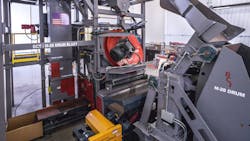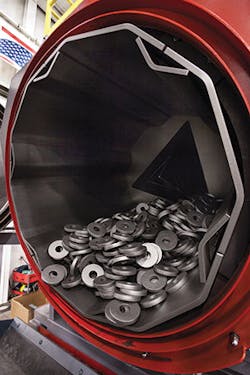Any plant operating a blast cleaning system knows that the problem in maintaining those systems is that the parts being manufactured tend to punish the production equipment. Cornell Forge Co. in Chicago operates a blast cleaning line to finish its carbon alloy (up to 100 lb.) and stainless steel (up to 30 lb.) products. It supplies manufacturers of heavy equipment for agriculture and off-highway equipment market, as well as hand tools, marine systems, railroads, and oil-and-gas exploration. (Cornell also produces titanium forgings for less ‘industrial’ markets, like medical devices and recreational products.)
In short, the plant’s operators understand what ‘rugged’ means, and what sort of ruggedness is needed in a blast cleaning operation. They needed to replace two traditional ‘tumblast’ machines that were no longer meeting the plant’s requirements for productivity, required excessive maintenance that led to unacceptable downtime -- and was incurring an unacceptable volume of scrap and damaged parts.
Cornell Forge Co. began this process of selecting a replacement machine by gathering competitive quotes from shot-blasting equipment builders, indicating it wanted a system that would improve process efficiency and throughput, and reduce cycle times and maintenance downtime. The search concluded with a visit to Blast Cleaning Technologies.
“While some things were similar with all manufacturers, several things stood out about Blast Cleaning Technologies,” according to Ray Raddatz, shipping and finishing supervisor. “Being a Midwestern company (New Berlin, WI) that manufactures heavy-duty equipment in the U.S was a big plus, as well as the tremendous knowledge of the entire team in shot-blasting, maintenance, safety and understanding the issues that Cornell was trying to address in the finishing department.
Raddatz continued: “However, the thing that really astounded the team during our tour of the (BCT) plant was the level of spare-parts inventory, and the care taken to handle and balance the quality of the tune-up kits and blade sets.”
The visit sealed the group’s decision to acquire a new machine from BCT — a 28 cu. ft. drum blast machine.
“The strength, durability and overall ‘aesthetics’ of the M-28 have been well received by our maintenance team,” Raddatz reported. “The “cartridge style” drives on the elevators were very well engineered, and conceived with maintenance in mind. This is a big plus for us, as we see this saving a tremendous amount of time in the future for elevator repairs.”
Cornell has experience running and maintaining all types and models of blast wheels, and the easy access to the new machine’s shot blast wheel has been particularly well received there. “The e-Wheel has saved in maintenance downtime and cycle times of 40 minutes have been improved by 50%,” he said.
One design detail that was particularly important to the Cornell crew was to select a system other than a traditional steel-flighted tumblast design. Cornell processes many smaller parts that were frequently ‘pinching in the tumblast and Cornell was determined to find a better blast solution.
The single, 28-D drum blast replaced two 22-cu.ft. tumblast machines. “The increase in productivity has been -old with the 28-D drum blast, and in one year we have saved $75,000 in maintenance downtime,” Raddatz said. “We’ve also saved on shot consumption and our scrap rate is less with significantly fewer parts being pinched and damaged.”
About the Author
Robert Brooks
Content Director
Robert Brooks has been a business-to-business reporter, writer, editor, and columnist for more than 20 years, specializing in the primary metal and basic manufacturing industries. His work has covered a wide range of topics, including process technology, resource development, material selection, product design, workforce development, and industrial market strategies, among others.

